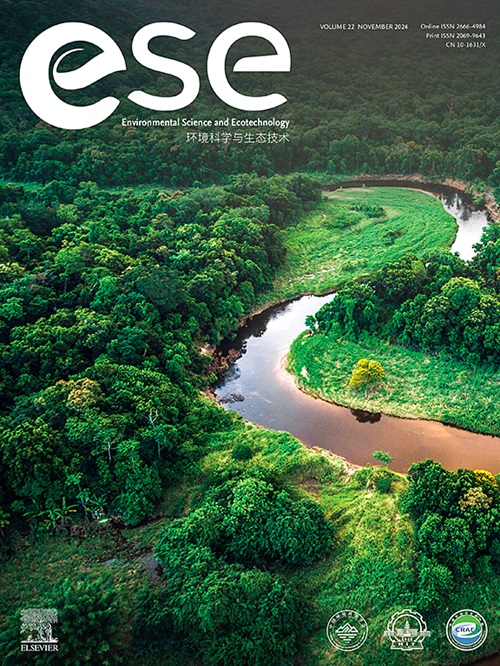节水策略减少废水处理厂的温室气体排放:多米诺骨牌效应
IF 14.3
1区 环境科学与生态学
Q1 ENVIRONMENTAL SCIENCES
引用次数: 0
摘要
污水处理厂(WWTPs)实现了城市水的回收利用,但也是温室气体(GHG)排放的重要来源。由于温室气体排放量与流入污水的体积和污染物负荷成正比,因此城市范围内的用水模式为污水处理厂的脱碳操作提供了一个直接但尚未得到充分研究的杠杆。人们对需求侧节水与工厂排放之间的反馈关系了解甚少,从而模糊了重要的缓解协同效益。在这里,我们展示了城市用水模式与污水排放碳排放之间的多米诺效应反馈。我们的分析表明,优化的水资源管理可以将污水处理厂的平均生态效率提高189%,从而每年减少483亿立方米的用水量,减少167万吨二氧化碳当量的温室气体排放。在这种水-碳协同管理情景下,废水行业可以在2037年实现碳中和,比仅依靠技术进步的计划提前7年。我们的研究结果提出了一个新颖的、可复制的框架,可以同时解决水资源短缺和气候变化问题。与成本高昂且实施缓慢的技术创新不同,利用农业和制造业等用水密集型行业的跨部门协同效应,为实现关键的碳减排目标提供了一条务实的途径。本文章由计算机程序翻译,如有差异,请以英文原文为准。

Water conservation strategies reduce greenhouse gas emission from wastewater treatment plants: A domino effect
Wastewater-treatment plants (WWTPs) enable urban water reclamation but are significant sources of greenhouse-gas (GHG) emissions. Because GHG output scales with the volume and pollutant load of influent sewage, city-wide water-use patterns offer a direct yet under-examined lever for decarbonizing WWTP operations. The feedbacks linking demand-side water conservation to plant emissions remain poorly understood, obscuring important mitigation co-benefits. Here we show a domino-effect feedback between urban water-use patterns with WWTP carbon emissions. Our analysis demonstrates that optimized water management can improve average WWTP eco-efficiency by up to 189 %, leading to an annual reduction in water consumption of 48.3 billion m3 and a decrease in GHG emissions by 1.67 million tons CO2-equivalent. Under this synergistic water-carbon management scenario, the wastewater sector could achieve carbon neutrality by 2037, seven years ahead of schedules based solely on technological advancements. Our findings present a novel and replicable framework that simultaneously addresses water scarcity and climate change. Unlike costly and slow-to-implement technological innovations, leveraging cross-sectoral synergies in water-intensive industries such as agriculture and manufacturing offers a pragmatic pathway to meeting critical carbon-reduction targets.
求助全文
通过发布文献求助,成功后即可免费获取论文全文。
去求助
来源期刊

Environmental Science and Ecotechnology
Multiple-
CiteScore
20.40
自引率
6.30%
发文量
11
审稿时长
18 days
期刊介绍:
Environmental Science & Ecotechnology (ESE) is an international, open-access journal publishing original research in environmental science, engineering, ecotechnology, and related fields. Authors publishing in ESE can immediately, permanently, and freely share their work. They have license options and retain copyright. Published by Elsevier, ESE is co-organized by the Chinese Society for Environmental Sciences, Harbin Institute of Technology, and the Chinese Research Academy of Environmental Sciences, under the supervision of the China Association for Science and Technology.
 求助内容:
求助内容: 应助结果提醒方式:
应助结果提醒方式:


